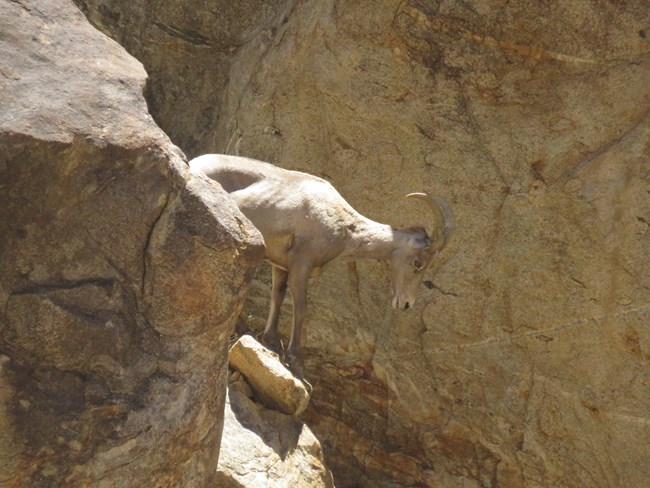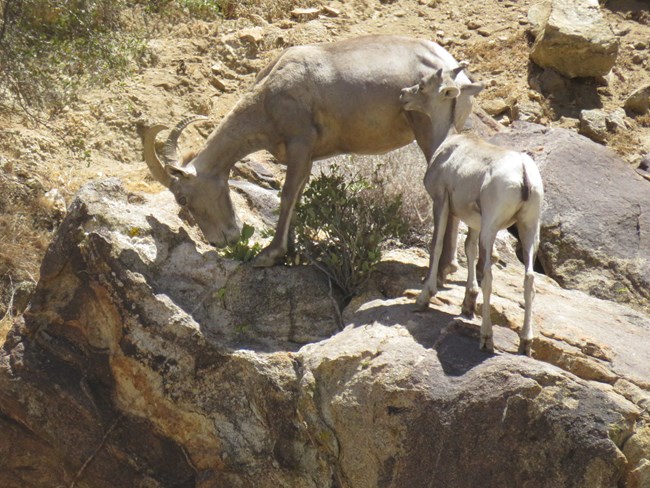Last updated: January 4, 2022
Article
Desert Bighorn Sheep: Living Life on the Edge

NPS/Hilary Clark
What adaptations do Desert Bighorn Sheep have?
Desert Bighorn Sheep (Ovis canadensis nelsoni) are true survivors, adapted to extremes. Cloven hooves give them the grace to climb up steep mountain ranges. A complex digestive system helps them absorb nutrients from tough desert plants, such as mesquite and catclaw.When did Desert Bighorn arrive in the Western Hemisphere?
Fossil evidence suggests that ancestors of modern bighorn crossed over the Bering Land Bridge, which connected the continents of Asia and North America, about 75,000 to one million years ago. Today, California is home to 3,000 to 5,000 bighorn. In Death Valley National Park, wildlife biologists have conducted research on bighorn sheep populations, and concluded that gene flow was high through the Funeral and Grapevine Mountains. Other populations of sheep, however, were more isolated. Wildlife biologists believe that metapopulations of bighorn sheep with gene flow are more resilient.How do you tell the difference between male and female bighorn?
Traveling in Utah, California, Nevada, or Arizona, you may have the good fortune of spotting a Desert Bighorn; the silhouette of its horns over a distant peak. Their horns are composed of keratin, which is the same material that makes up our fingernails. Male bighorns or rams will develop heavy horns that curl with age, whereas females will have thinner, less-pronounced horns. Rams will butt and lock horns in an attempt to demonstrate their physical prowess to females or ewes and their fitness as potential suitors.As bighorns age, they develop rings on their horns, similar to growth rings around a tree. Known as brooming, older rams will often file down their horns on rocks and break pieces off, so that they have an unobstructed view of predators using their wide set, amber eyes. Both rams and ewes will use their horns to break open a barrel cactus to get to its nutrient-rich pulp.
How much water do Desert Bighorn Sheep need to survive?
Bighorns need water to survive. During searing summer temperatures, bighorns will drink gallons of water at springs and other water sources. Access to water in the summer is particularly crucial for pregnant ewes. Walking on canyon floors toward a spring or coming down from a mountain range to a flowing river is one of the most dangerous ventures for bighorn sheep. Mountainous areas are escape terrain for bighorn sheep where they can get away from predators, such as mountain lions and coyotes. As a result, they will often avoid closed in areas with too much vegetation.When do Desert Bighorn Sheep mate?
At the age of two, ewes are sexually mature. They will come into estrus in July in low deserts and in August at the higher elevations. Rams can detect these elevated hormone levels for mating. The ram will curl his lip to test how receptive the ewe is toward his advances.Once pregnant, the ewe's gestation period is six months and the timing coincides with the greening of plants during spring months. Even in favorable conditions, a bighorn lamb has less than a 50 % chance of surviving its first summer. If lambs are fortunate enough to survive into adulthood, they will live an average of ten to fourteen years old.

NPS/Hilary Clark
What are the threats to the survival of Desert Bighorn Sheep?
Development, habitat fragmentation, disease and climate change are some of the threats that bighorn sheep face. Habitat fragmentation and development isolate bighorn populations that need wildlife corridors to mate and promote gene flow. Development can usurp water sources needed by the sheep, and dissect their habitat with deadly freeways.Along with these threats, bighorn are vulnerable to a type of bacterial pneumonia, transmitted from contact with domestic sheep. Even if this ovipneumoniae does not kill the adult bighorn, it will often result in lamb mortality.
Scientists are also concerned about the long-term impacts of climate change on bighorn sheep populations. Hotter temperatures and prolonged drought can cause springs to evaporate. It can also affect the nutritional value of plants, which is an important food source for a variety of wildlife.
Wildlife biologists are actively addressing threats to the survival of Desert Bighorn Sheep. The Park Service Biological Resources Division is working with Death Valley National Park, Mojave National Preserve, Joshua Tree National Park, and other partners to conduct a three-year study on bighorn connectivity. Through extensive research and projects, scientists hope to remove barriers and obstacles to bighorn sheep connectivity, such as modifying underpasses to create wildlife corridors. Despite these efforts, these iconic sheep, which can survive extreme environments, must contend with ongoing threats to their survival.
You can help!
- Respect closures in lambing areas.
- If you encounter bighorn sheep, stay at a respectable distance.
- Do not release Mylar balloons. Bighorn sheep and other wildlife can be injured or die from ingesting balloons.
- Do not plant oleander near bighorn sheep habitat. It is highly toxic to them.
- Volunteer to help with sheep counts and/or captures.
- Educate your family and friends about bighorn sheep and their significance.
